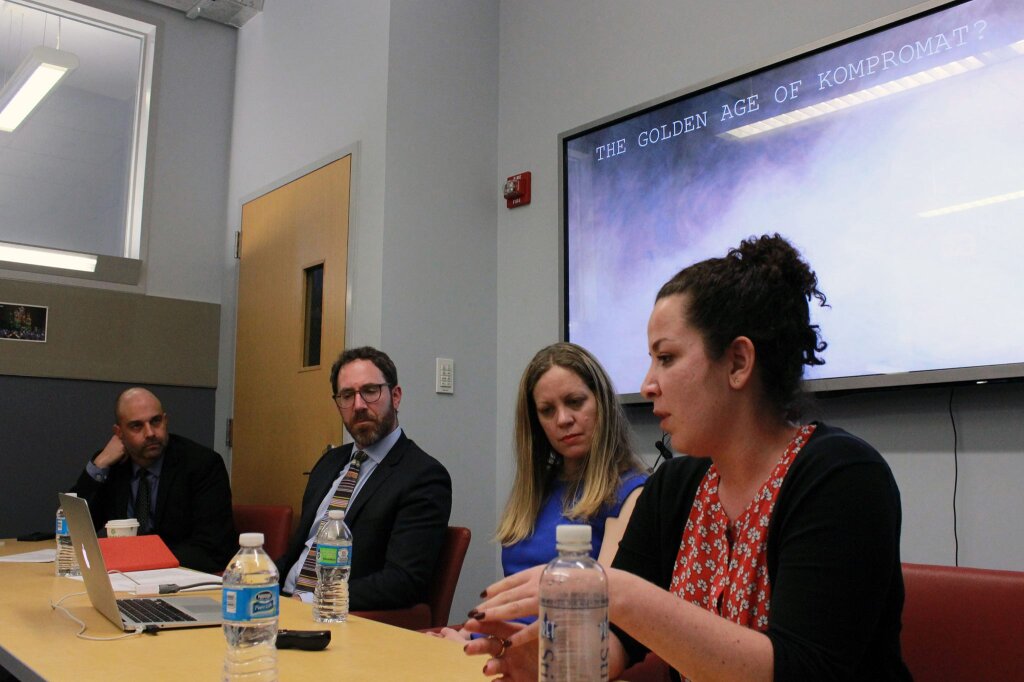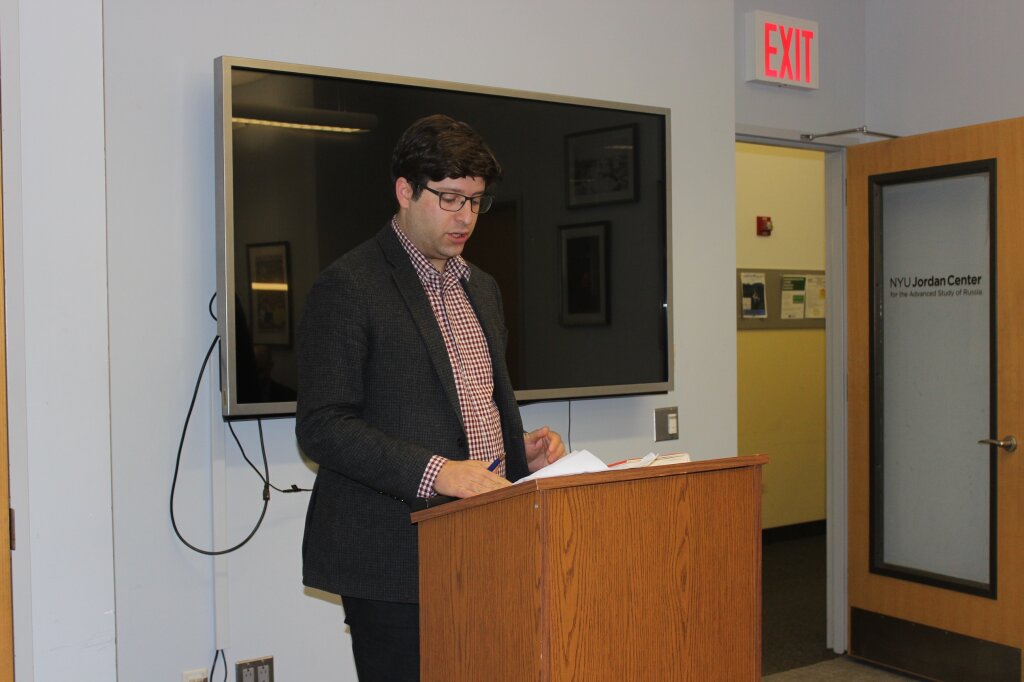Watch the video of the event here
On April 27, 2017, the Jordan Center for the Advanced Study of Russia at NYU and the Harriman Institute of Columbia University held a panel discussion entitled, “Kompromat: What it is, and what it means for U.S.-Russia relations” featuring panelists Keith Darden, an associate professor in the School of International Service at American University, Miriam Elder, BuzzFeed News’ World Editor, and Katy Pearce, assistant professor in the department of communication at the University of Washington. The event was co-chaired by Alexander Cooley, Claire Tow Professor of Political Science and director of the Harriman Institute and Joshua Tucker, professor of politics at NYU and director of the Jordan Center. The joint “New York City Russia Public Policy” initiative, supported by the Carnegie Corporation of New York, was the second installment in an ongoing series that works to establish a regular forum for academics and professionals in New York City to engage with pressing issues informing U.S.-Russia relations. This discussion detailed the history of kompromat in both the Soviet Union and post-Soviet successor states, the role it is currently playing in Russian politics, the ways in which in technological changes have impacted kompromat, and the potential effects of kompromat on U.S.-Russian relations.
As moderator, Tucker first introduced the panel of experts and turned the panel over to Darden, who began with some background on kompromat—what it is, why it’s used and why it’s politically relevant in the contemporary age. “Basically, it’s compromising material, [...] privately-held information that would cause you problems if it were made public,” he said. This type of information can range from morally compromising material about sexual intrigues and affairs to other kinds of communication that one would rather keep clandestine—for example, Victoria Nuland’s critical comments about the EU during the 2014 Ukrainian Revolution, which was tapped by either Ukrainian or Russian intelligence. “Those are embarrassing—they will damage a public reputation and that can cause considerable harm,” Darden said. But, he continued, “the more interesting aspects of kompromat are the things that would put you in jail”: financial inquiries, money laundering, and bribery. In these situations, “disclosure doesn’t just provide a reputational sanction, but a legal sanction,” Darden explained.
There are also two different uses of kompromat, Darden said. Most familiar is the release of kompromat because it’s visible. “That’s really designed to engage in defamation,” Darden said, pointing to U.S. politician Gary Hart’s extramarital affair. Political slander may be the most common use of compromising material in the U.S., but a study of the Soviet Union highlights a complex system of collection, blackmail and distribution. “The purpose of doing this is not to destroy people, but to make them your agents—to effectively control their behavior [...] in a way that gives you power over them,” Darden said. To keep sensitive information hidden, someone under threat might pay money, do favors, spy, or give other concessions. “These cases are invisible, which makes it particularly difficult to study,” Darden noted. There are also entire institutions devoted to collecting and using compromising material on a mass scale. These practices have girded strategies ranging from the FBI to Hitler’s SS, but the KGB is perhaps most infamous for its vast network of listening devices and staff trained in surveillance. “These networks were typically built on kompromat as well,” Darden said. “In other words, you entrap one person and you get them to spy on others, and it rolls out until you have a very significant portion of society engaging both in compliant political behavior and in surveillance itself.” What’s more, he added, “the KGB really specialized in this and it didn’t go away when the Soviet Union collapsed.” If anything, new technologies have also introduced revived methods of collection. “You don’t need a large surveillance apparatus to collect compromising material anymore,” Darden said, holding up his smartphone. Paradoxically, while cost has diminished, the pain of a release is still there.
Pearce next built on Darden’s presentation, focusing on how kompromat fits into the contemporary media environment, specifically in social media, and how the practice of kompromat has changed over time. “One of the ways that authoritarian regimes maintain control is through owning all the media,” she said, adding that “without justifiable alternatives, this means that verifying information is quite difficult. At any given time, anything is hypothetically possible and this renders individuals that live in such environments in a constant state of uncertainty.” In this kind of environment, rumor and scandal prosper and are often applied as a legitimate political strategy, she noted. Rumors are strengthened by evidence, which is where kompromat comes in.
Kompromat, Pearce said, gives a familiar idea a mysterious name: blackmail, “an age-old coercive technique.” However, the collection, blackmail and distribution of kompromat has changed in the past two decades. For instance, wiretapping phones and placing physical devices in people’s homes and hotel rooms used to be tedious, time-consuming and difficult. Distribution, even in the immediate post-Soviet period, was quite expensive and libel posed complications—it could cost as much as $30,000 to publish kompromat in a mainstream newspaper, Pearce noted. Significant changes occurred after the end of the Soviet Union, when a large privatization of intelligence gathering rendered many well-trained people jobless. As oligarchs scrambled to employ these professionals to exercise and extend their power, the digital revolution facilitated collection. “Think about how you use your phone or your camera today,” Pearce said. “We are self-generating kompromat all day long, [...] providing ample compromising material. People are constantly surveilling themselves and are under surveillance.” Contemporary audio and video recording devices are not only small and inexpensive, but can also work remotely. The Internet distributes information with a newfound ease, and online laws for libel content are not as robust as newspaper laws. “With this, I wonder if perhaps we are in the golden age of kompromat,” Pearce said. “Now that this term has entered the American vocabulary, [these aren’t] actions that are just for high-level politicians—this is going on with young adults all day long.”
Following Pearce’s presentation, Tucker interviewed Elder about her work with the Trump dossier (also known as the Steele memo), which BuzzFeed published in January 2017 and introduced the term kompromat to many people outside of the East European context for the first time. Elder said that the decision to publish the dossier occurred after CNN reported that the intelligence community was using it to brief then President Barack Obama and soon-to-be President Donald Trump. “That was a turning point,” she said. As the document was made available to newsrooms, think tanks, and politicians across America, “suddenly the existence of the dossier had become the story,” Elder said. “The decision at that point was pretty clear. We published it with the caveats that it was unverified, it contained some errors [...] at that point, it just became clear that the document itself was the story. It was time for the American people to have it.” Tucker also wondered whether Elder, a former Moscow bureau chief for The Guardian, felt that her personal experience working and living in Russia had fed into her decision. “Kompromat was constantly an issue [as Moscow bureau chief…] but more broadly, [there was] the constant idea that it could always happen,” Elder said. As bureau chief, for instance, she and her colleagues assumed their office was bugged. She also noted the cultural underpinnings of kompromat. She recalled that, during her tenure in Moscow, video tapes were leaked that captured several Russian opposition figures doing cocaine and having sex with a prostitute. But upon their release online, nothing happened. “It wasn’t a big deal and it brought home to me how much the context matters,” she said. “It’s not just the information in and of itself.” Finally, asked to reflect on her decision to publish the Trump dossier three and a half months later, “We are still trying to report it out,” Elder said.
Kompromat also envelops many stages, Tucker said, mentioning the importance of kompromat as a threat that loses its power after it is released. “Do we think that the power of kompromat has been diffused by the publicity of the memo? Would the Russian-U.S. relationship have been different in past few months?” he asked. In the Q&A session that followed, the audience further addressed the timeline of kompromat and its real-world applications in the present moment, such as in the French presidential elections in this past April and May. Regarding the Trump dossier, Pearce shared her skepticism that more than three months later, the document still holds sway over the American psyche. “I think the amount of content that we’ve all consumed since mid-January has allowed this to kind of fade away,” she said. In turn, Darden mentioned the “golden showers” fixated on by the media—what he considers the least interesting and least damaging claims in the dossier. “Those I think are defamed by the release [of the document].” But, he added, “the problematic ones are the ones where [Trump] broke the law, [...] where the release of that information means that a crime has been committed.” The KGB was a compliance and loyalty organization, Darden said, but “[the] FBI is a law enforcement organization. If it turns out that the president was an agent of a foreign intelligence service… he’s not immune from prosecution.”



